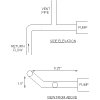P
PlumBum86
Does anybody know the formula used to calculate the height of the underside of the open vent pipe to the water level in the cwsc?
Thanks
Thanks
Welcome to the forum. Although you can post in any forum, the USA forum is here in case of local regs or laws

I am at my wits end trying to solve a venting problem and even though the pipe work has not been changed from when it worked without venting, in desperation I am looking at the height of the vent pipe above the F&E water level. My question refers to the diagram above. When it refers to the "static head and the lowest point", what is the lowest point? Is it the bottom of the lowest radiator or the bottom of the boiler? From the bottom of my radiators it is approximately 6.5 mtr and from the boiler about 5 mtr. The highest point of the vent pipe above the cwsc water level is 350mm. From the formula above it suggests this is about right. Confirmation that this is correct or otherwise, would be much appreciated.
Thank you lame plumber but being to new to this forum I do not know how to start a new post. But here is what has happened so far:you need to start your own thread and state exactly what you have been doing to the system to cause an issue, could be just a blockage but give it to us in full then you may get the right answer.


Reply to the thread, titled "Height of vent pipe formula" which is posted in UK Plumbers Forums on Plumbers Forums.
We recommend City Plumbing Supplies, BES, and Plumbing Superstore for all plumbing supplies.
